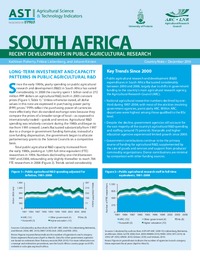Authors:
Flaherty, Kathleen; Liebenberg, Frikkie; Kirsten, Johann
Year:
2010
Publisher
International Food Policy Research Institute (IFPRI); University of Pretoria (UOP); and Agricultural Research Council (ARC)
Back to:
In 2008, South Africa’s public agricultural research agencies spent 1 billion rand or 272 million PPP dollars on agricultural R&D (both in 2005 constant prices) and employed 784 FTE research staff.
From a regional perspective, South Africa ranks second after Nigeria in terms of agricultural R&D investment and capacity levels. Although investment levels remain high compared with other African countries, South Africa is not meeting its agricultural research investment target of 3 percent of AgGDP. In 2008, for every $100 of agricultural output, South Africa invested $2.02 in agricultural R&D, one of the country’s lowest ratios since the 1980s.
While the ARC institutes continue to be primarily funded by the government through parliamentary grants, this funding can fluctuate considerably. Other sources of funding such as the sales of goods and services and support from commodity/producer organizations have declined, in part due to new mechanisms of levy collection and distribution. While contributions from donors have grown since 2000, the overall amounts are still quite small compared with other sources of funding.
ARC institutes lost ground from the mid-1990s until 2008, primarily due to fluctuating funding levels and staff dissatisfaction stemming from institutional restructuring. As a result, ARC lost over 300 FTE researchers during this time. Staff departures at ARC occurred at all degree levels but primarily by researchers holding BScs. Although this trend is partly a natural consequence of the shift toward a more competitive research environment and to increased involvement in agricultural research by the country’s higher education sector (which
attracted staff away from ARC), it nonetheless has possible implications for ARC’s future as older staff head into retirement.
The capacity of the provincial governments also declined between 2000 and 2008, and restructuring was again a factor to some degree in that it disrupted operations. As stated, overall research capacity in the higher education sector grew, although the universities are increasingly turning to part-time and contract staff for their research activities, rather than hiring permanent staff.

